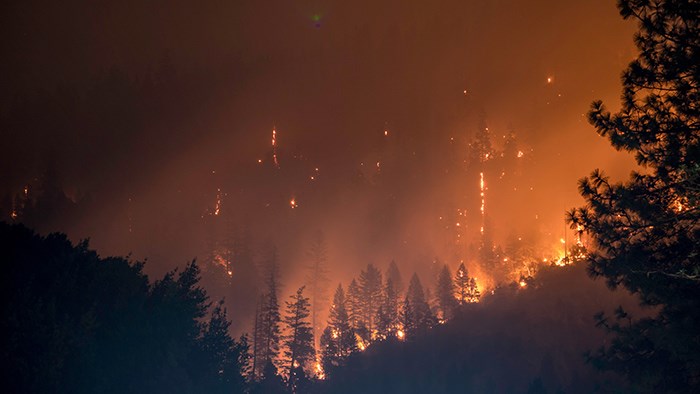 Matt Howard/Unsplash
Matt Howard/Unsplash
B.C.’s chances of experiencing wildfires and electricity infrastructure damages are lower than California’s due to climatic and geographic differences, BC Hydro says.
The state has been devastated with fires that swept through productive farmland, burned expensive Los Angeles residences, closed freeways and threatened the Ronald Reagan Presidential Library.
Hurricane-force wind gusts fanned wildfires across California, giving a respite for firefighters and residents overwhelmed by extreme fire warnings, evacuations and power outages affecting 160,000 residents to prevent sparking wires from causing further blazes. Some 200,000 people were under evacuation orders at one point.
Power shutoffs by Southern California Edison and Pacific Gas and Electric affected an estimated 1.2 million people.
While BC Hydro says the province is under no such threats now, the Preliminary Strategic Climate Risk Assessment for British Columbia released by the provincial government in July, said, “The risks of a severe wildfire season and
of a seasonal water shortage are the two highest-ranked risks facing the province overall in the 2050s.”
The report said severe wildfires are becoming more common and, in future, could “disrupt operations and damage infrastructure across multiple industries, including tourism, timber, mining and agriculture, resulting in economic losses. Wildfires may disrupt infrastructure systems such as transportation, electricity supply and telecommunications, water treatment and sewage systems.”
About 31,079.9 hectares have burned recently in California, compared with an estimated 1.3 million hectares in B.C.’s 2018 fire season. A total of 766,000 hectares burned in California in all of 2018.
BC Hydro spokesperson Susie Rieder said the provincial utility recognizes the increasing risk of wildfires in the province and continues planning to mitigate risks.
“One way we’re doing this is by maintaining a wildfire risk mapping system and conducting an annual system wide wildfire risk evaluation,” she said. “This enables us to revise our prevention and protection strategies as necessary and also allows us to focus resources where we expect it to be needed most.”
Rieder said California’s latitude influences its climate; the Santa Ana winds at this time of year often reach over 80 kilometres per hour and can quickly spread fires.
“Here in B.C. most of our wind events occur during the fall and winter months when fire risk is low,” Rieder said.
But, she said, wildfires can pose a significant risk to BC Hydro’s transmission system, distribution lines, substations and generation facilities.
When fire danger is extreme, Rieder said, circuits on distribution feeders in high-risk areas can be blocked.
“This means that if there is a fault, the line will automatically de-energize and not attempt to automatically re-close, or reconnect, which reduces the likelihood of starting a fire. In previous wildfire seasons, we’ve worked with the BC Wildfire Branch to construct firebreaks and install sprinklers at some remote sites when critical assets were at risk.”
And, she said, while most wildfires are started by people or lightning, the utility recognizes Hydro’s system can also pose risks of igniting wildfires. As a result, she said, “We have significant measures in place to manage and mitigate wildfire risk.”
When there are threats, Rieder said, corporate and regional emergency operations centres begin operations and communicate with the Provincial Emergency Program and various provincial agencies.
“Our emergency operations centres allow us to coordinate activities and allocate resources to help ensure an effective approach in protecting our system and our customers from outages,” Rieder said.
And, the Ministry of Environment and Climate Change said, it is the operators of critical infrastructure who are responsible for risk mitigation.
“In B.C., many critical infrastructure operators already demonstrate exceptional emergency management practices, often going beyond existing regulatory requirements, as observed during the 2017 and 2018 flood and wildfire events as well as in many other instances,” the ministry said in a statement.
“The provincial role is to have a regular dialogue with critical infrastructure partners to identify and potentially address any risks or threats to their infrastructure.”
Further, the ministry said, Emergency Management BC has established operational mechanisms to identify risks prior to and during an emergency by including critical infrastructure partners on preparedness and readiness coordination calls.
The ministry said it has made significant investments to mitigate fire concerns, including:
• Through the Forest Enhancement Society of B.C., a Crown agency, $235 million was invested in wildfire risk reduction, reforestation, forest rehabilitation and other efforts;
• Through the Community Resiliency Investment Program, $60 million was allocated to assist local governments and First Nations mitigate wildfire threats around their communities;
• An initial $10 million was provided for the development of a comprehensive prescribed burning program incorporating traditional ecological knowledge; and
• $500,000 was provided to the BC Cattlemen’s Association for an initiative to use grazing livestock to help manage fire fuels in parts of B.C., as part of ongoing efforts to help keep communities safe from wildfires.
“Our government has invested heavily in wildfire prevention and preparedness initiatives to help keep British Columbians safe and protect the province’s natural resources and infrastructure,” the ministry said.


